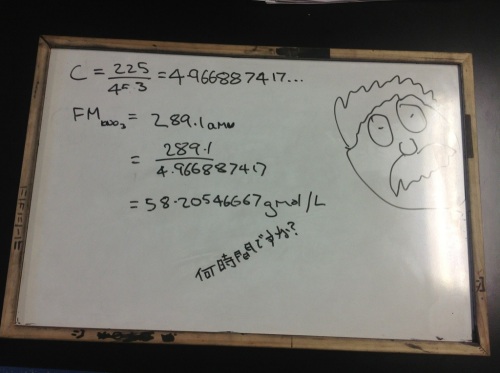On Friday my Year 11’s and I tried out something a bit bold, something that I’ve been wanting to try for awhile now: we played the mistake game.
As I mentioned in the previous post, with this class we’ve been working through the idea of molarity. They worked to arrive at the concept of molarity themselves, although it took some getting used to the change in the tone of the lesson from “teacher tells the answer” to “you have to decide for yourself”. For follow up, I decided to do some whiteboarding with them to practise calculating molarity.
Unfortunately, due to the complex nature of the school schedule it had been a few lessons since I had seen them, with an HSC exam in between. So they hadn’t had any proper time to practise and needed some guidance.
I had read Kelly’s guide to the Mistake Game and was really keen to inject this into my classes. In the Mistake Game, the students have to write up a solution to one of the problems that they have been working through. But – there’s a twist! Kelly describes it this way:
There’s a little wrinkle in the solution-writing part of whiteboarding. When we whiteboard in this class, we almost always play the Mistake Game. So the wrinkle is that you have to include at least one intentional mistake in your work. You can also include as many unintentional mistakes as you’d like.
For your intentional mistake, you should be trying to make a really good mistake. That means it should be something that you think your classmates might actually do. A lot of the time, a good way to come up with a quality mistake is to use something you actually did wrong when you were first solving the problem.
The students hadn’t encountered anything like this before – making mistakes was a problem to be overcome, rather than something to be encouraged. It certainly wasn’t an explicit part of the learning process! Here is an example of one group’s solution for the concentration of a copper sulfate solution:

It took them awhile to get into the groove, especially because they hadn’t actually worked through these problems yet (in future, I’ll make sure they have already developed a solution to help the discussion along). They also weren’t all that comfortable with the critique, but I tried to reinforce for them that we were getting our way to the solution together by consensus – it wasn’t about knocking each other down for no good reason.
There were some difficulties with the process. Firstly, the discussion was rather awkward to begin with. There was a lot of silence, uncertainty and unwillingness to contribute. The novelty of the activity certainly would have contributed to this, as they were still adjusting to what the activity actually entailed. Eventually this started to flow a bit more, but I felt that I had to lead the discussion more than I would have liked. Hopefully this will improve in future sessions.
Secondly, it showed that they were still unsure of what makes a productive discussion. I know that I’m still learning the skills of facilitating this kind of discussion, so I can believe that they were still learning what it’s like to participate in one. Some students were very reluctant to back their ideas and suggestions, whereas others were over confident and tended to dominate the discussion a bit more. I’d love to hear some suggestions on how to make this work more effectively.
But overall I really valued this process. There were a number of great things that came out and that I really want to encourage. I wanted to boost their metacognition – them thinking about their own thinking process, and trying to put themselves into the mind of another student to predict what mistakes they might make. I think this is a crucial problem solving skill to develop, so that they can analyse their own working and detect conceptual errors in their understanding.
It was also really useful for identifying their misconceptions. When I got myself out of the way and allowed the students to direct their own discussion, it really helped to show conceptual errors in their thinking that might have otherwise stayed hidden. I’d really love to know more about the best way to address these misconceptions, so any feedback is welcome.
It also helped to practise their whiteboarding skills – writing a solution for presentation, rather than just for working out as we have been using them for the majority of the time. I want them to think about layout and how their working flows, so that it is readable and understandable and doesn’t presume anything. Some have a way to go with this yet!

It was also fantastic to normalise the mistake making process. No-one is perfect when they start out, but to have full permission to get it wrong on the way to getting it right – that’s golden! I really look forward to doing some more.


Pingback: Mistake Game revisited | Chemistry Chris
Pingback: “Chalk” one up for Whiteboarding and the Mistake Game | Chemistry Chris